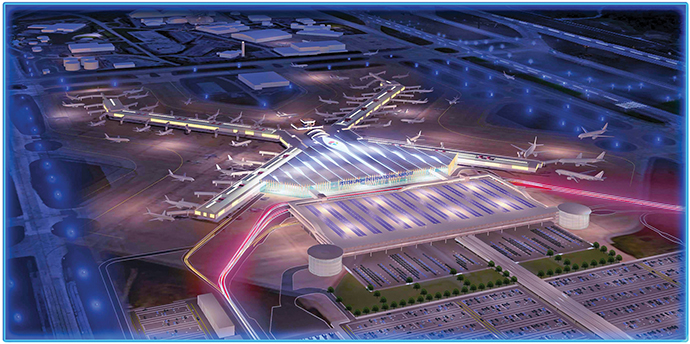Pittsburgh International Airport is enjoying an impressive resurgence, following the gut punch that struck it in 2004 when U.S. Airways shuttered its hub and millions of annual passengers vanished. The nadir may have come in 2011 when the airport, nearing default, tried to hire a new director but found no qualified takers, according to Rich Fitzgerald, Allegheny County Executive.
"With the loss of passengers, the finances were so bad that no one really wanted the job," says Fitzgerald.
Today, Pittsburgh International is poised at the brink of a four-year, $1.1-billion modernization while adding passengers, airlines and nonstop flights and pondering a potentially lucrative commercial development of thousands of acres of unused property.
What accounts for the turnaround?
As it turns out, star-crossed Pittsburgh International — much like airports in Denver, Dallas and Oklahoma City — sits on top of significant reserves of natural gas. "That," Fitzgerald tells Site Selection, "really started to change everything."
In 2013, the Allegheny County Airport Authority leased approximately 9,200 acres (3,723 hectares) to Pennsylvania-based CONSOL Energy, Inc., and received an up-front bonus payment of $46 million. Nineteen-percent royalty fees averaging nearly $1.4 million per month, according to airport spokeswoman Alyson Walls, started flowing at the beginning of 2017 when CONSOL began to draw gas from the ground.
"We’re probably looking at about $500 million to $800 million in on-going royalties over the next 20 years," says Fitzgerald.
"It’s made it possible to for us to make smart investments in our future, and that includes the modernization program," says Christina Cassotis, the Airport Authority’s CEO.
The ambitious modernization, to begin next year, looks to be the most tangible return from the airport’s shale reserves. Built in the 1980s to accommodate 35 million annual passengers, Pittsburgh International expects to set a post-hub high of some 9 million passengers this year.
"We have an airport," says Fitzgerald, "that was built for something that no longer exists."
Smaller Is Better
The former U.S. Airways terminal will be demolished and replaced by updated ticketing space, security and boarding areas as well as a new parking deck and a reconfigured international arrival concourse. A train that runs between the two existing terminals and costs millions of dollars a year to operate will be eliminated, as will several dozen gates. One of four existing runways might go away. Officials expect to cut per-passenger costs by 25 percent and thus offer lower fees to the airlines.

"We are going to be very well situated to absorb aggressive growth going forward," Cassotis tells Site Selection. "This is really about right-sizing and lowering costs."
Cassotis has held the airport’s leadership role for three years, a period during which nonstop destinations doubled from 37 to 74 while new airlines including Spirit, Frontier and Allegiant entered the market and existing carriers added flights. In 2017, the airport added nonstop flights to Reykjavik, Iceland, and Frankfurt, Germany, plus nonstop service to Montreal and Seattle. Recently, it welcomed two promotional flights from Shanghai and announced the resumption of service to London for the first time in nearly two decades. The four-day-a-week flights by British Airways will commence next April.
"The non-stop flight to London will absolutely make a difference in our ability to sell our region and attract increased investment," says Cassotis. "It’ll bring more tourists into the area.
"This community," she says, "understands really clearly that the airport is an economic generator, because when it doesn’t work at capacity in terms of serving the local market, then everybody suffers. As we’ve brought back flights, we know that this has a huge positive impact on the regional economy."
Filling in the Blanks
Pittsburgh International Airport sits on 8,800 acres (3,561 hectares), 3,000 of which are undeveloped. Office parks on the property already house call centers and warehousing, and Dick’s Sporting Goods has its headquarters at the end of a runway, complete with its own hangar. Officials are awaiting the completion of a land-use study with the idea of launching commercial development on a much broader scale.
"What gets situated on that land," says Cassotis, "is as impactful as the airline service that comes in. We want to know what should be there, what types of industries will really serve the region well and will help with the region’s goals. Pittsburgh’s economy has diversified into high tech, energy, higher education, healthcare and finance. So, what can we do at the airport with our land in order to see that one and one make three?"
Fitzgerald says the expected 2021 completion of Royal Dutch Shell’s $6-billion ethane cracker 10 miles away could have spinoff effects that will knock at the airport’s doors. "Along that corridor between the cracker plant and the airport, we envision that there’s going to be a lot of manufacturing opportunities for us."
To further leverage Pittsburgh International’s shale reserves, the Airport Authority will soon accept proposals for a natural gas microgrid to power the airport and to help lure manufacturing with the promise of cheap energy.
"Not only are we going to develop that land," says Cassotis, "but we’re hoping to offer the people who locate on it a low market rate energy cost. So, it’s a self-perpetuating loop. The industries that lend themselves to caring a lot about lower energy costs are in advanced manufacturing and data, so we think there’s a real opportunity to look at the intersection between that and those who want some proximity to an airport."

